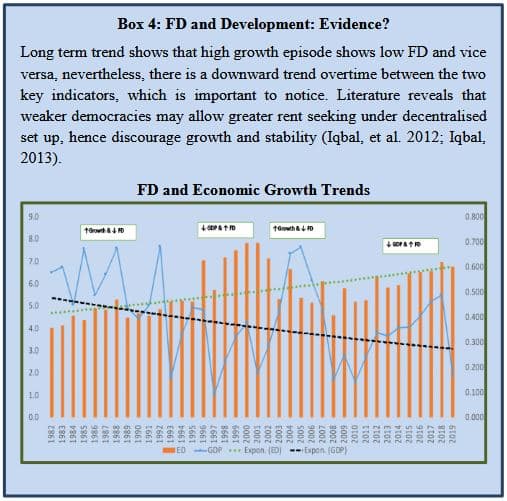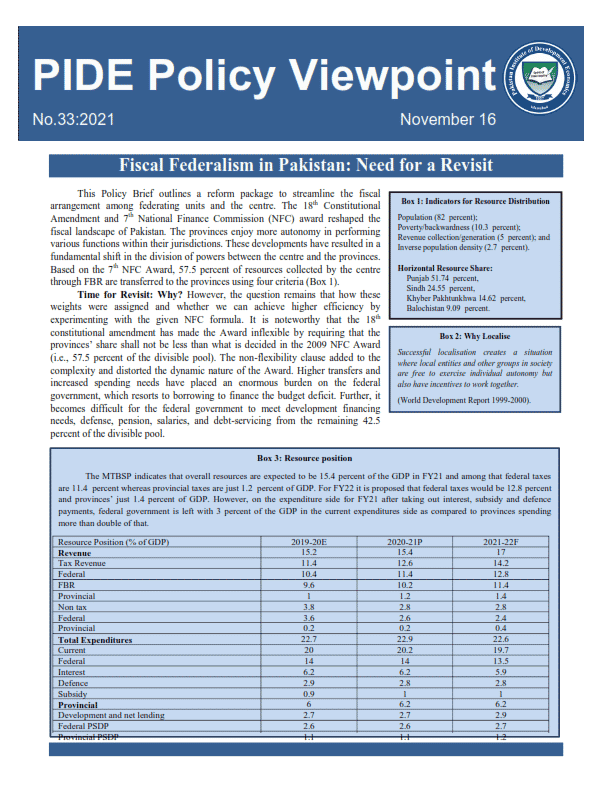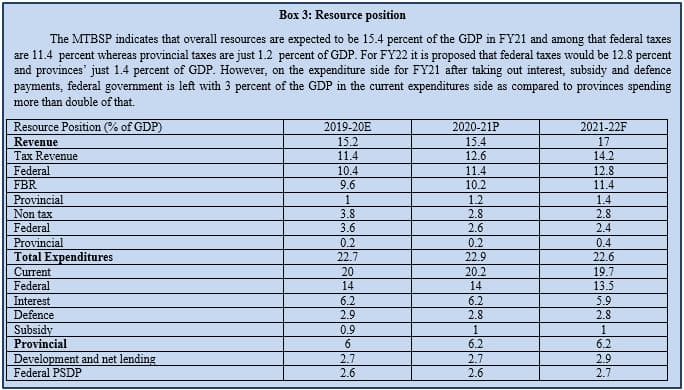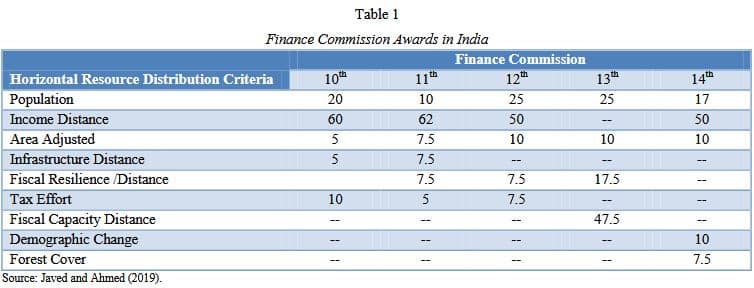
Pakistan Institute of Development Economics
- Home
Our Portals
MenuMenuMenuMenuMenuMenuMenu - ResearchMenuMenuMenuMenuMenuMenuMenu
- Discourse
- The PDR
- Our Researchers
- Academics
- Degree Verification
- Thesis Portal
- Our Portals
Fiscal Federalism in Pakistan: Need for a Revisit
Fiscal Federalism in Pakistan: Need for a Revisit
This Policy Brief outlines a reform package to streamline the fiscal arrangement among federating units and the centre. The 18th Constitutional Amendment and 7th National Finance Commission (NFC) award reshaped the fiscal landscape of Pakistan. The provinces enjoy more autonomy in performing various functions within their jurisdictions. These developments have resulted in a fundamental shift in the division of powers between the centre and the provinces. Based on the 7th NFC Award, 57.5 percent of resources collected by the centre through FBR are transferred to the provinces using four criteria (Box 1).
Time for Revisit: Why? However, the question remains that how these weights were assigned and whether we can achieve higher efficiency by experimenting with the given NFC formula. It is noteworthy that the 18th constitutional amendment has made the Award inflexible by requiring that the provinces’ share shall not be less than what is decided in the 2009 NFC Award (i.e., 57.5 percent of the divisible pool). The non-flexibility clause added to the complexity and distorted the dynamic nature of the Award. Higher transfers and increased spending needs have placed an enormous burden on the federal government, which resorts to borrowing to finance the budget deficit. Further, it becomes difficult for the federal government to meet development financing needs, defense, pension, salaries, and debt-servicing from the remaining 42.5 percent of the divisible pool.
| Box 1: Indicators for Resource Distribution Population (82 percent); Poverty/backwardness (10.3 percent); Revenue collection/generation (5 percent); and Inverse population density (2.7 percent). Horizontal Resource Share: Punjab 51.74 percent, Sindh 24.55 percent, Khyber Pakhtunkhwa 14.62 percent, Balochistan 9.09 percent. |
| Box 2: Why Localise Successful localisation creates a situation where local entities and other groups in society are free to exercise individual autonomy but also have incentives to work together. (World Development Report 1999-2000). |
Being a federal country, there is a need to assess whether the existing state of affairs can continue indefinitely, or it would be important that all the federating units assume the joint responsibility of anchoring sustainability and progress. Debt servicing, development, defense, and natural calamities (like Covid-19 and floods) necessitate better coordination and joint efforts.
Hence, joint coordinated efforts and a mechanism that can ensure it as a dynamic NFC formula. The resource distribution formula should contain the right set of incentives so that every federating unit puts in its best effort without externalising its expenditures upon others. Additionally, the mounting public debt and rising fiscal needs to finance defense had led to underfinance the social spending needs, thus resulting in miserable progress in social indicators. As a signatory to SDGs framework, financing needs require better coordination. This calls for a revisit of fiscal arrangements between the federal government and provinces to take into account these federational contexts also.
Provincial Revenue Generation: Historically, no systematic approach has been adopted to capacitate and encourage the provinces for revenue generation. For provinces, this has resulted in a long-term administrative and financial dependence on the centre (Ahmed, et al. 2007). To date, the major pressure for resource generation has been on centre and the FBR.
However, it is equally important to note that the federal government has overstretched itself by owning purely provincial matters. To mention a few, the federal government provides funds for roads, rural development, gender issues, SDG allocations, subsidy on fertilisers, Ehsaas/BISP[2], etc. This is against the basic premise of decentralisation and thus, compromises the expected efficiency gains. Each tier of the government should work in its domain and be encouraged to undertake spending based on indigenous initiatives and needs.[3] If backed by effective domestic revenue rising efforts, such spending would encourage greater accountability from the local electorate. This would also discourage the flypaper effect,[4] hence, would result in higher spending efficiency.
There is a need to devolve responsibility and empower provincial governments by giving the required resources (both human and financial) to develop their indigenous planning and development strategy as per local aspirations and territorial needs. All the devolved ministries, along with their personnel, need to be transferred to provinces in the true spirit of the 18th amendment to overcome the capacity deficit. Compromised capacity and contested decision space can give rise to duplication of efforts, inefficiencies, and lack of ownership (e.g., in higher education, health, poverty alleviation programmes (Ehsaas/BISP) and SDGs). Administrative empowerment encourages the provinces to contribute to the country’s development by streamlining their capacities and incorporating better voice and accountability from the local people (Ahmed, et al. 2007). Decentralisation should reduce provinces’ dependence on the centre, allowing the centre to concentrate more on the national issues. The economic loss due to the absence of a capacity-building mechanism and foregone resources in the provinces needs to be resolved (Khattak, et al. 2010).
Critical Questions for Debate: Besides resource transfers, it is also high time to evaluate the impact of the fiscal decentralisation (FD) process on key socioeconomic indicators to suggest a reform package for optimal utilisation of scarce resources. Various questions arise:
- What is the economic impact of the current FD mechanism in Pakistan?
- Are there enough incentives for each tier to perform?
- Are the federal and provincial governments complimenting or competing in efforts?
- Can matching grants provide the required incentive to cooperate on important social or economic initiatives?
- With a weak institutional framework, can Pakistan attain its objective of bringing prosperity to Pakistani people through FD?
- Can each province with its particular context generate local receipts and expand the economy? Having enjoyed around 60 percent of the total divisible pool for the last ten years, it is high time to assess which sectors remained a priority of the provincial governments. We need to see how the current and development spending has progressed.
- Are the additional funds meant for the local people actually reaching them in the right proportion, or instead, there is a second-degree elite capture and centralisation at the second tier?
- Assessment revenue raising efforts of provincial governments in areas that fall under subnational jurisdiction.
- Is the 18th constitutional amendment optimal, or we may revisit it after a thorough assessment?
- Are we happy with the current idiosyncratic response on higher education, health, and environment, or should there be a consolidated response?
 __________________________
__________________________
[1] Federal government has initiated the process to renegotiate the fiscal arrangements between centre and provinces through the 10th NFC Award formulation but it has yet to bear results after initial jolts. Following the initial notification of NFC (on May 18, 2020), there were reservation from within the province on the nominated member for Balochistan. A new nomination had to be made in the revised notification (on July 22, 2020).
[2] which is though debatable due its impact on achieving equality across the nation.
[3] FD help to achieve better resource management through competition among the local governments (Ebel and Yilmaz, 2002) where citizens vote with their feet (Tiebout, 1956).
[4] Local autonomy in domestic revenue raising, restricts the non-productive government spending (Rodden, 2002).
| Box 5: International Evidence on Resource Distribution The Finance Commission of India has a dynamic setup where they have experimented different criteria and have tried alternative weights. The awards has posed less reliance on population (which is a crude expenditure need criterion). Instead, more weight has been allotted to either incentive based (Income distance, infrastructure distance, fiscal resilience, fiscal capacity and tax effort) or objective based (area, demographic change and forest cover) criteria (see Table 1). The most important element, which enables them to experiment each time, is the non-political, professional setup at Finance commission. Despite criticism on certain aspects, the Commission has announced financial award each time and more importantly tried different distribution criteria. This inclusion of multiple criteria and regular revisit is though criticised in the literature however the point to emphasise here is to leave no stone unturned until optimal solution is sorted out. Similarly, developed countries like Canada and Australia keep their focus solely on Equalisation Funds with the aim to cover differences in revenue raising capacity and to overcome the cost disabilities of delivering similar services across regions. These efforts though are framed in a manner that do not distorts revenue collection efforts of the states, thus saves efficiency component. |
Suggestions for Reform
- In the wake of tight fiscal space and increasing targeted spending, we recommend matching grants from the central divisible pool as one of the criteria. This will develop a larger political consensus on major socio-economic initiatives. For example, SDGs spending can be financed from NFC on a matching grants basis. Pakistan has already utilised the matching grants mechanism in the 1996—NFC Award.
- To make NFC a dynamic resource sharing mechanism, the Council of Common Interest (CCI) can be used as a forum to decide a common socio-economic goal for each year on a rolling basis. The currently reserved ‘one percent share of KPK (for war against terror)’ can be utilised against the most urgent needs with mutual consensus in CCI, e.g., Covid-19 for this year, FATA merger, dams, SEZs in each province or alike.
- Fiscal equalisation is an internationally accepted criterion; however, there is a need to revisit the current ‘need-based’ NFC allocations.
- This is indicated through major allocations being made on a population basis. We need to move towards incentive-based resource allocation.
- Reduce the weight of “Population”—being a flat indicator of expenditures needs only.
- Instead of revenue collection, more weight should be allotted to revenue generation or revenue growth.
- Within the need-based elements, a certain percentage should be allotted to the income gap or HDI-gap to encompass quality of life in the formula.
- Subsequently, allocate a certain percentage to the indicators of “Tax effort (tax revenue – tax potential).” It would be important, though to cap the negative figures (especially in the case of Balochistan as well as in the case of natural calamity/pandemic) and promise a benchmark figure to achieve consensus.
- To streamline the utilisation of poverty-related resources in social-protection programs, the new NFC may ensure that the annual social-protection budget of a provincial government should not be less than the amount of the divisible pool based on poverty and backwardness indicators. This can be managed through conditional transfers, making it mandatory for provinces to utilise funds meant for social protection on related avenues only.
- Revisit the 18th constitutional amendment and make the NFC transfers flexible
- Consensus can be developed to form a fund where the centre and the provinces could pool resources for national development e.g., dams, CPEC infrastructure, mega-development projects, and resource & mineral extraction. Once completed, the royalties should be distributed as per contributions.
- NFC success is based on PFCs—this needs to be embedded in the fiscal transfers formula.
- Political consensus for NFC Award needs to be built based on economic principles. This can be made possible by making the permanent secretariat for NFC at CCI, manned by professionals and supported by a data bank (having a continuous stream of data collection and processing).
- Make the criteria dynamic. Pakistan has been following formula transfers which change rarely. In contrast, the resource distribution mechanism around the world is dynamic and regularly revisits the indicators, their weights as well as the mechanism to address the changing needs and to provide adequate incentives for enhancing efficiency. This is what NFC in Pakistan needs to focus the most.
REFERENCES
Ahmad, I. (2021). It is high time we revisited the NFC Awards in Pakistan. (PIDE Blog, May 19, 2021).
Ahmad, I., Mustafa, U., & Khalid, M. (2007). National finance commission awards in Pakistan: A historical perspective. PIDE. (PIDE Working Paper Series 33).
Ebel, R. D. & Yilmaz, S. (2002). Concept of fiscal decentralisation and worldwide overview. World Bank Institute.
Iqbal, N., Din, M. U., & Ghani, E. (2012). Fiscal decentralisation and economic growth: Role of democratic institutions. The Pakistan Development Review, 51(3), 173–195.
Iqbal, N. (2013). Fiscal decentralisation, democratic institutions and inflation. The Pakistan Development Review, 52(3), 207–220.
Javed, S. A. & Ahmed, V. (2019). NFC Award: Devising formula for horizontal distribution. SDPI. (SDPI Working Paper No. 173).
Khattak, N., Ahmad, I., & Khan, J. (2010). Fiscal decentralisation in Pakistan. The Pakistan Development Review, 49(4).
Rodden, J. (2002). The dilemma of fiscal federalism: Grants and fiscal performance around the world. American Journal of Political Science, 46(3), 670–687.
Tiebout, C. M. (1956). A pure theory of local expenditures. The Journal of Political Economy, 64(5), 416–424.





